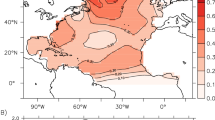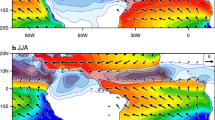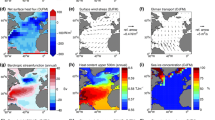Abstract
A multi-model analysis of Atlantic multidecadal variability is performed with the following aims: to investigate the similarities to observations; to assess the strength and relative importance of the different elements of the mechanism proposed by Delworth et al. (J Clim 6:1993–2011, 1993) (hereafter D93) among coupled general circulation models (CGCMs); and to relate model differences to mean systematic error. The analysis is performed with long control simulations from ten CGCMs, with lengths ranging between 500 and 3600 years. In most models the variations of sea surface temperature (SST) averaged over North Atlantic show considerable power on multidecadal time scales, but with different periodicity. The SST variations are largest in the mid-latitude region, consistent with the short instrumental record. Despite large differences in model configurations, we find quite some consistency among the models in terms of processes. In eight of the ten models the mid-latitude SST variations are significantly correlated with fluctuations in the Atlantic meridional overturning circulation (AMOC), suggesting a link to northward heat transport changes. Consistent with this link, the three models with the weakest AMOC have the largest cold SST bias in the North Atlantic. There is no linear relationship on decadal timescales between AMOC and North Atlantic Oscillation in the models. Analysis of the key elements of the D93 mechanisms revealed the following: Most models present strong evidence that high-latitude winter mixing precede AMOC changes. However, the regions of wintertime convection differ among models. In most models salinity-induced density anomalies in the convective region tend to lead AMOC, while temperature-induced density anomalies lead AMOC only in one model. However, analysis shows that salinity may play an overly important role in most models, because of cold temperature biases in their relevant convective regions. In most models subpolar gyre variations tend to lead AMOC changes, and this relation is strong in more than half of the models.














Similar content being viewed by others
References
Ba J, Keenlyside NS, Park W, Latif M, Hawkins E, Ding H (2013) A mechanism for Atlantic multidecadal variability in the Kiel Climate Model. Clim Dyn 41:2133–2144. doi:10.1007/s00382-012-1633-4
Bacon S, Gould WJ, Jia Y (2003) Open-ocean convection in the Irminger Sea. Geophys Res Lett 30(C5):1246
Bellucci A, Gualdi S, Scoccimarro E, Navarra A (2008) NAO-ocean interactions in a coupled general circulation model. Clim Dyn 31:759–777. doi:10.1007/s00382-008-0408-4
Bjerknes J (1964) Atlantic air-sea interaction. Adv Geophys 10:1–82
Booth BBB, Dunstone NJ, Halloran PR, Andrews T, Bellouin N (2012) Aerosols implicated as a prime driver of twentieth-century North Atlantic climate variability. Nature 484:228–232. doi:10.1038/nature10946
Cunningham SA, Kanzow T, Rayner D, Baringer MO, Johns WE, Marotzke J, Longworth HR, Grant EM, Hirschi JJM, Beal LM, Meinen CS, Bryden HL (2007) Temporal variability of the Atlantic meridional overturning circulation at 26.5 degrees N. Science 317(5840):935–938. doi:10.1126/science.1141304
Curry RG, McCartney MS, Joyce TM (1998) Oceanic transport of subpolar climate signals to mid-depth subtropical waters. Nature 391:575–577
Delworth TL, Greatbatch RJ (2000) Multidecadalthermohaline circulation variability driven by atmospheric surface flux forcing. J Clim 13:1481–1495
Delworth TL, Mann ME (2000) Observed and simulated multidecadal variability in the Northern Hemisphere. Clim Dyn 16:661–676
Delworth TL, Manabe S, Stouffer RJ (1993) Interdecadal variations of the thermohaline circulation in a coupled ocean-atmosphere model. J Clim 6:1993–2011
Deser C, Blackmon ML (1993) Surface climate variations over the North-Atlantic Ocean during winter—1900–1989. J Clim 6:1743–1753
K-1 model developers (2004) In: Hasumi H, Emori S (Eds), Coupled GCM (MIROC) description, K-1. Technical report No. 1
Dickson R, Lazier J, Meincke J, Rhines P, Swift J (1996) Longterm coordinated changes in the convective activity of the North Atlantic. Prog Oceanogr 38:241–295
Eden C, Jung T (2001) North Atlantic interdecadal variability: oceanic response to the North Atlantic Oscillation (1865–1997). J Clim 14:676–691
Eden C, Willebrand J (2001) Mechanism of interannual to decadal variability of the North Atlantic circulation. J Clim 14:2266–2280
Enfield DB, Mestas-Nuñez AM, Trimble PJ (2001) The Atlantic Multidecadal Oscillation and its relation to rainfall and river flows in the continental U. S. Geophys Res Lett 28:2077–2080
Gastineau G, Frankignoul C (2012) Cold-season atmospheric response to the natural variability of the Atlantic meridional overturning circulation. Clim Dyn 39:37–57
Gordon C, Cooper C, Senior C, Banks H, Gregory J, Johns T, Mitchell J, Wood R (2000) The simulation of SST, sea ice extents and ocean heat transports in a version of the Hadley Centre coupled model without flux adjustments. Clim Dyn 16:147–168
Griffies SM, Tziperman E (1995) A linear thermohaline oscillator driven by stochastic atmospheric forcing. J Clim 8:2440–2453
Guemas V, Salas-Mélia D (2008) Simulation of the Atlantic meridional overturning circulation in an atmosphere–ocean global coupled model. Part I: a mechanism governing the variability of ocean convection in a preindustrial experiment. Clim Dyn 31(1):29–48
Gulev SK, Latif M, Keenlyside NS, Park W, Koltermann KP (2013) North Atlantic Ocean control on surface heat flux on multidecadal timescales. Nature. doi:10.1038/nature12268
Hall M, Bryden H (1982) Direct estimates and mechanisms of ocean heat transport. Deep Sea Res Part A 29:339–359
Hatun H, Sando AB, Drange H, Hansen B, Valdimarsson H (2005) Influence of the Atlantic subpolar gyre on the thermohaline circulation. Science 309:1841–1844
Hawkins E, Sutton R (2007) Variability of the Atlantic thermohaline circulation described by three-dimensional empirical orthogonal tunctions. Clim Dyn 29:745–762
Hazeleger W, Wang X, Stefanescu S, Severijns C, Bintanja R, Sterl A, Wyser K, Semmler T, Yang S, van den Hurk B, van Noije T, van der Linden E, van der Wiel K (2012) EC-Earth V2.2: description and validation of a new seamless earth system prediction model. Clim Dyn 39:2611–2629
Isachsen PE, Mauritzen C, Svendsen H (2007) Dense water formation in the Nordic Seas diagnosed from sea surface buoyancy fluxes. Deep Sea Res I 54:22–41
Jungclaus JH, Haak H, Latif M, Mikolajewicz U (2005) Arctic-North Atlantic interactions and multidecadal variability of the meridional overturning circulation. J Clim 18:4013–4031
Jungclaus JH et al (2010) Climate and carbon-cycle variability over the last millennium. Clim Past 6:723–737
Kanzow T, Cunningham SA, Rayner D, Hirschi JJM, Johns WE, Baringer MO, Bryden HL, Beal LM, Meinen CS, Marotzke J (2007) Observed flow compensation associated with the MOC at 26.5 degrees N in the Atlantic. Science 317(5840):938–941
Kavvada A, Ruiz-Barradas A, Nigam S (2013) AMO’s structure and climate footprint in observations and IPCC AR5 climate simulations. Clim Dyn. doi:10.1007/s00382-013-1712-1
Keenlyside NS, Ba J (2010) Prospects for decadal climate prediction. Wiley Interdiscip Rev Clim Change 1(5): 627–635. ISSN 1757-7799
Knight JR, Allan RJ, Folland CK, Vellinga M, Mann ME (2005) A signature of persistent natural thermohaline circulation cycles in observed climate. Geophys Res Lett 32:L20708
Knight JR, Folland CK, Scaife AA (2006) Climate impacts of the Atlantic Multidecadal Oscillation. Geophys Res Lett 33:L17706
Kushnir Y (1994) Interdecadal variations in North Atlantic Sea surface temperature and associated atmospheric conditions. J Clim 7:141–157
Latif M, Keenlyside NS (2011) A perspective on decadal climate variability and predictability. Deep Sea Res 10:1016
Latif M et al (2004) Reconstructing, Monitoring, and Predicting Multidecadal-Scale changes in the North Atlantic thermohaline circulation with sea surface temperature. J Clim 17:1605–1614
Latif M, Collins M, Pohlmann H, Keenlyside N (2006) A review of predictability studies of Atlantic sector climate on decadal time scales. J Clim 19:5971–5987
Lazier J, Hendry R, Allyn Clarke, Yashayaev I, Rhines P (2002) Convection and restratification in the Labrador Sea, 1990–2000. Deep Sea Res I 49:1819–1835
Mann ME, Bradley RS, Hughes MK (1998) Global-scale temperature patterns and climate forcing over the past six centuries. Nature 392:779–787
Marini C and Frankignoul C (2013) An attempt to deconstruct the Atlantic Multidecadal Oscillation. Clim Dyn. doi:10.1007/s00382-013-1852-3
Marotzke J (1997) Boundary mixing and the dynamics of three-dimensional thermohalinecirculations. J Phys Oceanogr 27:1713–1728
Marshall J, Schott F (1999) Open-ocean convection: observations, theory, and models. Rev Geophys 37:1–64
Marti O et al (2010) Key features of the IPSL ocean atmosphere model and its sensitivity to atmospheric resolution. Clim Dyn 34:1–26
Mecking JV, Keenlyside NS, Greatbatch RJ (2013) Stochastically-forced multidecadal variability in the North Atlantic: a model study. Clim Dyn. doi:10.1007/s00382-013-1930-6
Medhaug I, Furevik T (2011) North Atlantic 20th century multidecadal variability in coupled climate models: sea surface temperature and ocean overturning circulation. Ocean Sci 7:389–404
Medhaug I, Langehaug RH, Eldevik T, Furevik T, Bentsen M (2012) Mechanisms for decadal scale variability in a simulated Atlantic meridional overturning circulation. Clim Dyn 39:77–93
Menary BM, Park W, Lohmann K, Vellinga M, Palmer MD, Latif M, Jungclaus JH (2012) A multimodel comparison of centennial Atlantic meridonal overturning circulation variability. Clim Dyn 38:2377–2388
Oka A, Hasumi H, Okada N, Sakamoto TT, Suzuki T (2006) Deep convection seesaw controlled by freshwater transport through the Denmark Strait. Ocean Model 15:157–176
Otterå OH, Bentsen M, Bethke I, Kvamstø NG (2009) Simulated pre-industrial climate in Bergen Climate Model (version 2): model description and large-scale circulation features. Geosci Model Dev 2:197–212
Otterå OH, Bentsen M, Drange H, Suo LL (2010) External forcing as a metronome for Atlantic multidecadal variability. Nat Geosci 3:688–694
Park W, Latif M (2010) Pacific and Atlantic multidecadal variability in the Kiel Climate Model. Geophys Res Lett 37:L24702. doi:10.1029/2010GL045560
Park W, Keenlyside NS, Latif M, Stroeh A (2009) Tropical Pacific climate and its response to global warming in the Kiel Climate Model. J Clim 22:71–92
Pickart RS, Straneo F, Moore GWK (2003) Is Labrador Sea water formed in the Irminger Basin? Deep Sea Res Part I 50:23–52
Pohlmann H, Smith DM, Balmaseda MA, Keenlyside NS, MasinaS, Matei D, Müller WA, Rogel P (2013) Predictability of the mid-latitude Atlantic meridional overturning circulation in a multi-model system. Clim Dyn. doi:10.1007/s00382-013-1663-6
Pope V, Gallani M, Rowntree P, Stratton R (2000) The impact of new physical parametrizations in the Hadley Centre Climate Model—HadCM3. Clim Dyn 16:123–146
Randall DA, Wood RA, Bony S, Colman R, Fichefet T, Fyfe J, Kattsov V, Pitman A, Shukla J, Srinivasan J, Stouffer RJ, Sumi A, Taylor KE (2007) Climate models and their evaluation. In: Solomon S, Qin D, Manning M, Chen Z, Marquis M, Averyt KB, Tignor M, Miller HL (eds) Climate change 2007: the physical science basis. contribution of working group I to the fourth assessment report of the intergovernmental panel on climate change. Cambridge University Press, Cambridge, United Kingdom and New York, NY, USA
Schlesinger ME, Ramankutty N (1994) An oscillation in the global climate system of period 65–70 years. Nature 367:723–726
Semenov VA, Latif M, Dommenget D, Keenlyside NS, Strehz A, Martin T, Park W (2010) The impact of North Atlantic-Arctic multidecadal variability on northern hemisphere surface air temperature. J Clim 23:5668–5677
Sutton RT, Hodson DLR (2005) Atlantic Ocean forcing of North American and European summer climate. Science 309:115–118
Timmermann A, Latif M, Voss R, Groetzner A (1998) Northern Hemisphere interdecadal variability: a coupled air-sea mode. J Clim 11:1906–1931
Ting MF, Kushnir Y, Seager R, Li CH (2011) Robust feathers of Atlantic multi-decadal variability and its climate impacts. Geophys Res Lett 38:L17705
Vellinga M, Wu P (2004) Low-latitude freshwater influence on centennial variability of the Atlantic thermohaline circulation. J Clim 17(23):4498–4511
Visbeck M, Cullen H, Krahmann G, Naik N (1998) An ocean model’s response to North Atlantic Oscillation-like wink forcing. Geophys Res Lett 25:4521–4525
Voldoire A, Sanchez-Gomez E, Salas y Mélia D, Decharme B, Cassou C, Sénési S, Valcke S, Beau I, Alias A, Chevallier M, Déqué M, Deshayes J, Douville H, Fernandez E, Madec G, Maisonnave E, Moine MP, Planton S, Saint-Martin D, Szopa S, Tyteca S, Alkama R, Belamari S, Braun A, Coquart L, Chauvin F (2013) The CNRM-CM5.1 global climate model: description and basic evaluation. Clim Dyn 40(9–10):2091–2121. doi:10.1007/s00382-011-1259-y
Volodin EM, Dianskii NA, Gusev AV (2010) Simulation present day climate with the INMCM4.0 coupled model of the atmospheric and oceanic general circulations Izvestia RAS. Atmos Ocean Phys 46:414–431
Wouters B, Drijfhout S, Hazeleger W (2012) Interdecadal North-Atlantic meridional overturning circulation variability in EC-EARTH. Clim Dyn 39(11):2695–2712
Yeager S, Karspeck A, Danabasoglu G, Tribbia J, Teng H (2012) A decadal prediction case study: late 20th century North Atlantic Ocean heat content. J Clim 25:5173–5189. doi:10.1175/JCLI-D-11-00595.1
Zhang R (2010) Latitudinal dependence of Atlantic meridional overturning ciruclation (AMOC) variations. Geophys Res Lett 37:L16703. doi:10.1029/2010GL044474
Zhang R, Delworth TL (2006) Impact of Atlantic multidecadal oscillations on India/Sahel rainfall and Atlantic hurricanes. Geophys Res Lett 33:L17712
Zhang L, Wang C (2013) Multidecadal North Atlantic sea surface temperature and Atlantic meridional overturning circulation variability in CMIP5 historical simulations. J Geophys Res Oceans 118:5772–5791. doi:10.1002/jgrc.20390
Zhang R, Delworth TL, Held IM (2007) Can the Atlantic Ocean drive the observed multidecadal variability in Northern Hemisphere mean temperature? Geophys Res Lett 34:L02709
Zhang R, Delworth TL, Sutton R, Hodson D, Dixon KW, Held IM, Kushnir Y, Marshall D, Ming Y, Msadek R, Robson J, Rosati A, Ting MF, GA (2013) Have aerosols caused the observed atlantic multidecadal variability? J Atmos Sci, 70(4). doi:10.1175/JAS-D-12-0331.1
Acknowledgments
We thank the Deutsche Forschungsgemeinshaft under the Emmy Noether programme (Grant KE 1471/2-1) supported JB and NK. Support from the European Community’s 7th framework programme (FP7/2007–2013) under grant agreement No. GA212643 (THOR: Thermohaline circulation—at risk? 2008–2012), No. 266722 (SUMO) and PCIG10-GA-2011-304243 (STEPS); RACE project funded by German Federal Ministry for Education and Research; and the Centre for Climate Dynamics are acknowledged. Computing resources from GEOMAR and Rechenzentrum der Universität Kiel are greatly appreciated.
Author information
Authors and Affiliations
Corresponding author
Rights and permissions
About this article
Cite this article
Ba, J., Keenlyside, N.S., Latif, M. et al. A multi-model comparison of Atlantic multidecadal variability. Clim Dyn 43, 2333–2348 (2014). https://doi.org/10.1007/s00382-014-2056-1
Received:
Accepted:
Published:
Issue Date:
DOI: https://doi.org/10.1007/s00382-014-2056-1




